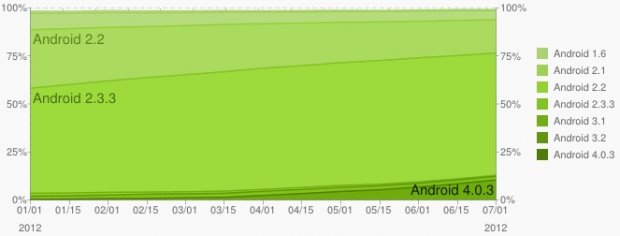|
|
2012-07-03
, 11:40
|
|
Posts: 322 |
Thanked: 218 times |
Joined on Feb 2012
|
#12
|
Originally Posted by gerbick

Yes, I have seen similar for Europe, 18 months is the average. Lots of people get new phones after 12 months, lots after 24 or longer.
Then it means that it's time for an update for most folks - 18-24 months is the norm.
I think it's pretty common knowledge that Honeycomb just wasn't ready for primetime, it was really Gingerbread at a different dpi density and a lot of clean up had to happen that started with ICS, now it's fully done at Jelly Bean.
Simply stated, skipping from one version of Android to the newest one is perhaps the best case scenario and likely to happen for most folks. You'd have to be a fan, rich, or stupid (or combinations therein) to have experienced each and every version of Android.
Most people with Android though have gotten their phones during the last year. Still, 90% are running on software that is 19 months or older. Only 10% are running on ICS. ICS is already 9 months old and Jelly Bean is what ICS should have been in the first place.
|
|
2012-07-03
, 15:26
|
|
|
Posts: 2,427 |
Thanked: 2,986 times |
Joined on Dec 2007
|
#13
|
Sorry, but if you can read a trend graph you'll notice the concave shape of the Android 4 curve vs. the convex shapes of Android 2.*.
Nice try, but fragmentation is decelerating.

Info found here:
http://developer.android.com/about/d...rds/index.html
Nice try, but fragmentation is decelerating.
Info found here:
http://developer.android.com/about/d...rds/index.html
__________________
N9: Go white or go home
N9: Go white or go home
 |
| Tags |
| op is the, troll ericsson |
«
Previous Thread
|
Next Thread
»
|
All times are GMT. The time now is 12:35.







This is all based on a warped reality understanding. With or without an agenda.
So the user base use older versions now than they did when Android was in 1.6. That's not only expected, it's the normal use case. Hardly anyone have ever had an fresh OS version on their Windows Mobile, Symbian, Series 40, or any other phone, beyond the first month in sale. Heck, the same goes for PCs and microwaves, too. Nokias Windows Phone 7 won't be upgradeable to Windows 8 either.
Android and other upgradeable cell phone platforms are improvements on the standard use case, not lagging behind.
Even if it took a year from new version till phone production, hardly anyone use phones older than two years. Google knows this and plans accordingly. Cell phone builders thrive in this and base their sale expectancies on it.
Google, IOS and other upgradeable OS's are all way better on upgrades than ANYTHING was prior to the cell phone OS revolution.
Edit: hopefully somewhat better grammar.
Qwerty is hot? Stylus or not? Let the buyer decide! The Nokia ¹ Smartphone - Build your ¹
Last edited by volt; 2012-07-03 at 11:40.